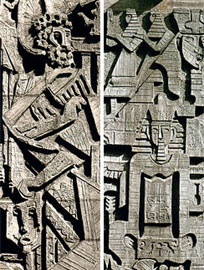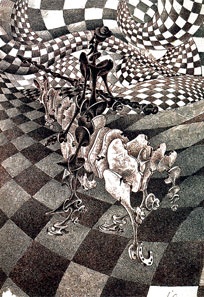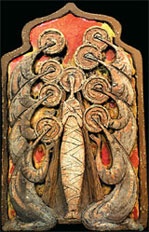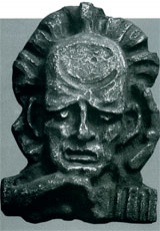|
https://www.tretyakovgallerymagazine.com/articles/1-2015-46/nikolai-silis-palindrome-artist
Nikolai Silis. The Palindrome Artist
Olga Gerasimova
Article: PORTRAIT
OF THE ARTIST
Magazine issue: #1
2015 (46)
THE SCULPTOR NIKOLAI SILIS WAS BORN IN 1928 IN MOSCOW, IN
THE GRAUERMAN MATERNITY HOSPITAL ON THE ARBAT: THE SILIS
FAMILY LIVED NEARBY, IN A COMMUNAL FLAT ON GOGOLEVSKY
BOULEVARD. HIS FATHER, ANDREI SILIS, WAS SHOT IN DECEMBER
1941, ON TRUMPED-UP CHARGES, IN THE UKHTIZHEMLAG LABOUR
CAMP. HIS MOTHER, YEKATERINA, MIRACULOUSLY SURVIVED THE
BLOCKADE OF LENINGRAD, WHERE THE FAMILY HAD TO MOVE AFTER
THE FATHER'S ARREST. YEKATERINA SUCCEEDED IN SENDING HER TWO
SONS, THE OLDER RUFIM1
AND THE YOUNGER VADIM, AWAY TO RELATIVES LIVING NEAR THE
TOWN OF KALININ.
It was by chance that Nikolai Silis chose the Stroganov
School of Art and Crafts, which had opened in 1945 after a
15-year-long interval, although before the war Nikolai's
mother used to take him to museums in Leningrad and, of
course, to the Hermitage. It was then that Nikolai developed
a particular fascination with monumental sculpture because
the city, with its gorgeous monuments which had survived the
perils of destruction could not but inspire him towards art.
The statues by Vasily Demut-Malinovsky, Mikhail Kozlovsky,
Peter Clodt and Etienne Maurice Falconet left a lasting
impression in his mind and, at a later time, inspired him to
create a series of drawings called "Centaurs"2.
The Stroganov School attracted him most of all because there
was only one exam to be taken - in painting - and also
because it offered a dormitory, a stipend and a uniform. For
a young man getting by during the hunger-stricken postwar
years, these factors proved crucial. Nikolai wanted to
enroll in the Stroganov School's painting department but
failed the test and gained admission instead to the artistic
stone-cutting department, where artisans were trained. The
Stroganov School was envisaged in 1945 as a new kind of
educational establishment. Its Department of Sculpture
offered training in design in such areas as stone-cutting,
bronze, wood and wall painting on plasterboard. After
graduating from the school of craftsmen and on review of his
graduation work, Silis received a recommendation for study
at the department of sculpture. His graduation work in
stone-cutting was a marble copy of the antique statue "A Boy
Pulling out a Thorn".
The Stroganov faculty then included the painters Vasily
Bordichenko, Vladimir Yegorov, Pavel Kuznetsov, Alexander
Kuprin; the sculptors Georgy Motovilov and Saul Rabinovich;
the architects Leonid Polyakov and Alexander Rochegov; and
the art historians Mikhail Alpatov and Nikolai Sobolev. A
student of Alexander Matveyev, Saul Rabinovich in the 1930s
studied in Antoine Bourdelle's Parisian workshop; at the
Stroganov School he was nicknamed "Saul from Paris"3.
It was Motovilov, the head of the sculpture department, "a
power-loving, resolute and bold person with progressive
aesthetic views"4,
who succeeded in recruiting young sculptors to teach at the
school. Things were humming at the Stroganov, "even at
midnight you could see a dozen students in the sculpture
workshops"5.
In the years of struggle against cosmopolitanism Motovilov
and Rabinovich were criticized for formalism. They were
accused of often mentioning Bourdelle, Maillol and Ronsard:
"Neither Saul nor Motovilov succeeded in proving that they
preferred Russian art to Western art and were labeled as
cosmopolites"6.
Motovilov warded off the peril when he joined Nikolai
Tomsky's team to create the bas-relief "vladimir Lenin and
Josef Stalin - Founders and Leaders of the Soviet State".
With a dozen other sculptors working on the project he was
rewarded with the Stalin Prize First Degree in 1950 and
became unassailable for critics.
After studying at the Stroganov School for eight years,
Silis joined other artists - Vladimir Lemport and Vadim
Sidur - to form the famous "trio". However, for a year or
two the group included a fourth member, Boris Barkov, who
was taken on board in order to dilute the "non-Russian"
family names. Lemport and Barkov graduated from the
Stroganov School in 1950, Sidur and Silis in 1953. But
Barkov left the team so quickly that nobody even remembers
that he was once a member. After Barkov left, the group
assumed the name "LeSS" (Lemport-Sidur-Silis), with which
they signed all their works irrespective of who was the
author. The group stayed together for about ten years
before, inevitably, breaking up. However, for several years
after the split they continued to share a studio, on
Komsomolsky Prospect near Park Kultury metro station, where
they worked together from 1954 through until 1968.
The fact that the "LeSS" group existed for a while at all is
remarkable: it is hard to imagine now how three such
creative personalities could stay together. All three were
young, talented and, ultimately, ambitious.
Lemport, Sidur and Silis met each other while they were
studying at the Stroganov School. After the war, some of the
students were soldiers fresh from the battlefield, like
Konstantin Gneushev, Sidur, Lemport and Ivan Kharchevin,
while some were fresh from school, including Illarion
Golitzin, Yevgeny Shcheglov, Lev Tokmakov, Yury Orekhov and
Silis.
The idea to set up as a trio, like the already existing "Kukryniksy"
group, occurred to the three of them while still at school.
At the beginning "LeSS" was referred to as "Kukryniksy in
Sculpture"7.
According to a commentator on the correspondence between
Sidur and Karl Eimermacher, Sidur was the initiator of the "LeSS"
group8.
All three were talented not only in their specialization but
in other spheres as well. For instance, each was good at
writing, leaving behind not only published stories, essays
and literary translations9,
but also diaries, which each of the trio members kept for
several years beginning from October 196010.
In addition, Lemport and Silis were involved in film-making
in the 1960s-1970s.
Initially all three practiced a realist style: it could not
have been otherwise. One would assume that in the early
1950s they did not even think about pursuing formalism,
especially considering that after the war the struggle
against the style swept over the country, and the art
colleges were not left unscathed.
The sculptors worked as a team, although over the years each
of them inevitably acquired a particular artistic
vocabulary, recognizable manner and style.
The first "LeSS" project was designing two bas-reliefs -"Labour"
and "Science" - for the facades of the buildings of the
Moscow State University Physics and Chemistry departments,
which in 1949 were under construction on the Lenin Hills.
For Lemport it was a graduation work (under Motovilov's
guidance), for Sidur and Silis a pre-graduation work. As
Silis recalled later, the architect Lev Rudnev offered them
the assignment.
In 1954 Sidur and Silis were granted membership of the
Moscow Union of Artists (Barkov and Lemport had been
admitted earlier). One would have thought that the future
looked promising for them - clients, success and prosperity
were just around the corner. But such a direction was not to
become central to the three young men's life.
From the very beginning they gained a reputation among the
general public as rebels who dared to criticize the
unofficial monopoly in Soviet sculpture. The "Sovetskoe
iskusstvo" (Soviet Art) newspaper ran an article "About the
young professionals and old rules [Letter to the editor]",
signed by Barkov, Lemport and Sidur. They wrote about the
need to synthesize architecture and sculpture and about the
lack of organization in the area of decorative sculpture.
They argued that there was no institution to unite sculptors
who worked with architects.
But when, nearly a year later, they wrote a second article,
they did not expect the reaction that followed. The article
was devoted to an assignment to design the Palace of Culture
and Science in the centre of Warsaw, with Lev Rudnev the
project's leading architect. Designed in the style similar
to that of the "Moscow skyscrapers", the palace was a gift
to the Polish people, to be financed by the USSR. Working on
the project, "LeSS" made sketches for 10 statues in the
niches and designed the interior decor of the Palace, which
Rudnev praised. But then he suddenly signed on Nikolai
Tomsky, Georgy Motovilov, Mikhail Baburin and Lev Muravin,
recommending that Lemport, Sidur and Silis be hired as
assistants. According to Lemport, all three were desperate.
It was at this point that the three sculptors for the first
time ran up against arrangements that for many years had
proved a sinecure for a select group of sculptors. That was
the basis behind the article in "Literaturnaya gazeta"
(Literary Gazette) titled "Against Monopoly in Sculpture",
which described a small group of sculptors thriving on
unfair privileges - big names who physically could not
handle all the projects they were employed on and, as a
result, used private sculptural "enterprises" with regularly
employed sculptor assistants. These assistants, responsible
not only for technical work but for creative aspects as
well, were never credited, and nobody knew about them. This
situation where a client entrusted the project to a master
whose name alone seemed to guarantee success brought about
"serious failures"11,
and, speaking frankly, shoddy pieces of work that only
remotely resembled art. The authors of the article suggested
to create conditions favourable for the work of young
artists - to provide groups of young artists with studios,
and to abolish competitions in which only select groups of
artists could participate. In addition to Barkov, Lemport,
Sidur and Silis, the article was signed by Silis's fellow
students, Bodrov and Bratsun.
The authors of the article knew from their own experience
how such "assistants" worked in the studios of illustrious
Soviet sculptors. As a student, Silis earned extra money as
an assistant to the sculptor Alexei Yeletsky, creating a
tombstone for an army general - Yeletsky enjoyed great
renown in Moscow for this type of job. Silis recounted this
episode in his essay "Old Sretenka"12.
Later he worked as a stone-cutter for Tomsky and in Yevgeny
Vuchetich's studio in a church on Solyanka.
The authors of the article had touched on an issue of
lasting importance for Soviet monumental art - a subject
which nobody dared to talk about, much less air in public.
Since the article in "Literaturnaya Gazeta" was without
precedent, the sculpture section of the Moscow union of
Artists spent three entire days (June 1, 5, 29)13
discussing it. Some speakers criticized the authors, others,
on the contrary, supported them. A commission was set up,
with Lemport brought on board, to address the issue under
discussion. And on the third day of the debates - June 29 -
the commission read out its resolution (the full text is
missing from the archive file, however). The response was a
series of additions and amendments. But the documents of the
central committee of the communist Party of the USSR,
published in 200114,
show that the commission's resolution reached its addressee,
the Ministry of Culture.
Thus, we can conclude that the article "Against Monopoly in
Sculpture" was a catalyst for a conflict that had been
brewing for a long time, which explains why the authors were
not publicly punished. However, there were consequences: it
should be remembered that some of the students of Yevgeny Vuchetich, like Matvei Manizer, Georgy Motovilov and Nikolai
Tomsky became functionaries in various official
organizations managing art, and Lemport, Sidur and Silis had
to come into regular contact with them when they sought
approval for their projects or submitted already finished
works15.
It should be also noted that after the publication of
"Against Monopoly" Rudnev commissioned from "LeSS" only two
three-and-a-half meter high figures for the Warsaw project.
One of them, "Sport", represented Silis as an athlete,
another, "Architecture", represented Lemport as an architect
holding the model of a skyscraper in his hands. Both statues
still adorn the Palace in Warsaw. All the other sketches and
ideas were rejected, Sidur's two statues - "Textile
Industry" and "Geography" - remaining only in the form of
sketches.
Later on, when each of the sculptors had his own studio to
work in, they would feel compelled to adhere to the
principles that they had adopted in the 1950s - not to
create shoddy work merely for profit, and not to participate
in the non-conformists' movement. Both options were
unacceptable for them. They chose to work for themselves, to
move in their own artistic orbits, without contributing to
the loud and, for that reason, memorable actions of the
non-conformists. The fact that they had to accept
assignments from the crafts Workshop, the Khudozhestvenny
Kombinat, should not be regarded as a betrayal of their
artistic credo. On the contrary, each of the three was eager
to give his own personal touch to each commissioned work.
This mark of "being different from the others" would leave a
lasting impact on each of the members of the trio, even when
two of them, Lemport and Silis, had parted ways with the
third, Sidur. After their bold criticism their works were no
longer accepted for shows. Perhaps the first and only large
exhibition to feature the artwork of each sculptor
comprehensively was the trio's solo show at the Academy of
Fine Arts in Moscow in 1956. A modest catalogue gives an
idea of the scale of their activity: sketches, small
statues, clay dishes (138 pieces in all)16.
In the same year, 1956, "LeSS" was for the first time
awarded a prize at the first open competition for the best
design of a monument commemorating the 300th anniversary of
the reunification of ukraine and Russia. But, according to
Sidur, after the jury opened the envelope and read out the
winners' names, the organizers of the competition decided to
cancel the first prize and to award honourable mention
awards. Ernst Neizvestny received a similar honourable
mention prize.
During the World Festival of Youth and Students, which
afforded Westerners a glimpse of the Soviet union, an
exhibition of prints and sculptures at the Gorky central
Park of culture and Leisure in July-August 1957 featured one
piece from each member of the group. Silis displayed the
wooden composition "Young Girl".
According to the art scholar vladislav Zimenko, the Silis
piece demonstrates an overwhelming fascination with "the
external, rhythmic, textural expressiveness to the detriment
of substance"; this "aesthetic ideal... is quite removed
from our life, from the real beauty we want to see in art.
It does not befit us to celebrate the relaxed, mistily
dreamy or deeply 'sensual youth'."17
The critic very aptly characterized the style of Silis, for
whom, in his own words, sculpture reflected his inner world.
It was then, in the late 1950s-early 1960s that Silis's
individual artistic vocabulary in sculpture took shape. As
Lemport reminisced later, for about seven years Silis helped
him and Sidur, without revealing his own artistic
personality. "And then once, sometime in 1960, returning
after a month's absence, Sidur and I saw a new wooden statue
the size of a human being. We realized that Silis... had
cast away the chains of slavery and now his rightful
artistic personality had to be reckoned with"18.
The female figure is key in Silis's works. The abstract,
formalist female figures made of stone, wood, chamotte or
bronze or sketched in drawings became the culmination of his
artwork.
In the early 1960s it was decided to produce several
thousand stone replicas of some of the "LeSS" pieces,
including Silis's "Girl Squeezing Her Hair Dry". At the same
time, his pieces "Youth" and "Girl with a Skipping Rope"
were rejected by the artistic council on account of their
"formalist style".
In the same period, the 1960s, Silis produced small pieces,
some of which were replicated in large quantities in
plastic, like the desktop pieces "Girl on a Ball",
"Skaters", "Woman on a Beach". His statues representing
humans appear abstract. The poet Nikolai Starshinov, using
"Skaters" as an example, characterized the essence of these
pieces: "... the sculptor did not aspire to represent
specific real-life skaters when he imaged their dress, body
or even facial features. He was eager to convey their drive
for victory, their speed, their energy, their soaring. And
he achieved this!.."19.
It should be noted that later, when the sculptor had an
opportunity, he copied several of his pieces in bronze.
Bronze lent new features to the sculptures that had
initially been made of stone - when you look at them, you
want to touch them, to feel their forms.
One of the works produced in this period is the famous "silisoid"
- "solenoid" - an abstract piece to be placed in front of
the Kirensky Institute of Physics of the Siberian Branch of
the Russian Academy of Sciences in Krasnoyarsk. Permission
to mount this statue could be secured only with a written
explanation of its usefulness, and the physicists crafted a
letter to the Moscow Union of Artists arguing at length that
this sculpture emanated super-strong magnetic fields. True,
when the piece was being discussed before approval, the
chairman of the artistic council Lev Kerbel left the room -
its formalist style was too obvious for him to accept it.
In the late 1960s Christian themes began to appear in
Silis's artwork, with the first work in this vein his
"Crucifixion" (1969). The reliefs made of chamotte and smalt
- "The Entombment" and "Lamentation" (both from 1970) - are
so memorable precisely due to the formalist contours of the
figures and the fluency of the features. The next project
was the iron piece "Parasceva" (1971), a piece also marked
by the sculptor's original style: his is not a canonical
image of the saint, and his treatment differs from that of
the church. "Parasceva" is emphatically much larger than the
two male figures by her side: her body is taller, the arms
longer than normal. She seems to be towering over the men,
defending them, begging the Lord's forgiveness for people's
acts. The material and the welding technique enabled the
sculptor to avoid naturalism in the saint's image. The
uneven and coarse texture of the iron produced the effect of
concealment of a naked body.
After the "LeSS" trio broke up in 196820,
Silis and Lemport worked together as a team of two until
Lemport's death. Silis summarized this experience: "Everyone
grew up, and now each had an individuality different from
that of the others. Besides, sooner or later every group is
bound to have a leader. I could not be one because of my
age, and Sidur and Lemport were equal in this fight.
ultimately, as the matter stood, our ways had to part."21
Silis notes that both Lemport and Sidur spurred him into
self-development. They were not mentors or teachers, rather
they were opponents who incited him to "contrariness".
The relationship between Lemport and Silis was not always
smooth, either. Silis respected Lemport for his
craftsmanship in portraiture, but Lemport did not favour
Silis's sculptures. At times the wall of misunderstanding
presented itself not only in the form of the sculptors
ignoring each other, but also as a very real partition
diagonally dividing the studio on Aleksa Dundic street22.
Silis in partnership with Lemport worked on many projects
involving monumental sculpture. unfortunately, some of them
remained unaccomplished, and some pieces were simply
dismantled. That was what happened to the decorative mural
on the front wall of the concert Hall at the Tchaikovsky
Museum in Klin.
That relief was not the sculptors' only creation to be
destroyed. The same thing happened to the stone mural "Old
Russian Warriors" (1966) inside the building of the Arbat
restaurant. The unaccomplished projects included the design
of the Olympics office on Gorky Street and the front wall of
the main office building of the car maker AMO ZIL (both from
1966), as well as reliefs for the Oktyabr Cinema (1967). For
the last project, a revetment was built to carry reliefs
featuring scenes from films, which were initially made of
clay and then molded; the final product was to be made of
stone23.
Shortly before Lemport's death the revetment was gifted to
the Mosfilm film studio. Another dismantled piece was an
iron sculpture mounted in 1967 on the front of "Dom Svyazi"
(Communication House), on Kalinin Prospect (now Novy Arbat,
2). The Minister of Communications Psurtsev disapproved of
the iron emblem shaped by Silis as a female figure - he
believed it looked too frivolous. The piece was removed from
the outside and mounted inside the building, but
unfortunately it has not survived. The design for the
Russian National Library of Foreign Literature (1967)
remained unrealized as well.
But it would not be true to say that all of Silis's and
Lemport's projects remained unaccomplished. Their realized
projects include the design of the Soviet Embassy in Nigeria
and a relief in the reception room at the Embassy in Athens,
as well as the design of libraries in Ashgabat and
Rostov-on-Don, a theatre in ufa, a "Yunost" retreat near
Moscow, and a caucasus sanatorium in Kislovodsk. And the
conflict between the two sculptors reveals itself even in
these works. According to Silis, neither the exterior design
projects nor the interior design ones emerged as a single,
whole piece. The opinions of the sculptors working together
differed radically. First there were disputes, followed by
one of the sculptors falling in line with the other. Thus,
working on a relief called "Swimming Women", for the Oreanda
hotel in Yalta, Lemport, instead of stylized details,
depicted women's heads. The overall image conformed with
Silis's design, but its integrity was violated by Lemport,
who could not stand stylization in joint projects. The heads
were remade in a non-abstract manner, but with the
abstraction Silis's initial concept was gone as well.
In 1970-1980s Silis worked a lot with wood, creating not
only statues but also reliefs. Especially remarkable among
these pieces is a three-figure composition "Morning. Day.
Evening". This piece compellingly reveals the sculptor's
reverential attitude to the material and the subject. The
female figures appear as both earthly and otherworldly; the
abstract ovals of faces, necks drawn out as sprouts, brittle
hands and the whiteness of the bodies stand in sharp
contrast to the dark, rough tree bark. What did the sculptor
want to say with this? Probably he wanted to highlight the
enigma nestled within every female soul, this soul's primary
natural grace and purity.
In 1976 Silis created a gypsum Don Quixote, later replicated
in bronze, and in 1989 a smaller copy of the statue became
the emblem of the Tarkovsky Prize. The Knight of the Ill-favoured
Face from La Mancha is represented as an incorrigible
romantic gazing at a flower in his hand. It is obvious that
the rough iron armour hides an ardent heart which never
stops wondering and, therefore, feeling and loving.
Don Quixote is featured in a series of drawings created in
1975-1976. The artist places him in fantastic situations, as
if testing his endurance. Silis's Don Quixote is placed as
if in zero gravity: he crosses a chessboard-patterned field
on a wooden horse, gazes at a scrap metal heap, encounters,
instead of a mill, an electrical transmission line, gallops
across a forest of rockets, and the like. Through his
treatment of the wandering knight's image Silis sends a
message to the viewers about the fearlessness of Don
Quixote, who cherishes his love for Dulcinea. The sculptor
succeeded in conveying his admiration for "Woman" through
his male hero.
Both in the 1990s and the 2000s the artist produced drawings
as well as objects in wood and bronze. The pieces created in
that period include "Naiads", "Fantasies," "Circus Women in
a Circle" and many others. In these works Silis used
artistic idioms he had applied before, such as smooth, fluid
lines, as well as new ones, such as emphasis on drapes
enveloping female figures or fragmentarily featured in the
compositional arrangements. These features figure in his
bronze pieces: "Walking Woman" (1991), "Strange Woman"
(1992), "Sitting Woman in Drapes" (2001), and in the wooden
sculpture "Pregnant Women" (1997).
Silis, the youngest among the three sculptors, the one who
had never experienced war, for a long time remained in the
shadow of his older fellows, Lemport and Sidur. According to
Yury Koval, the writer and artist who knew all three
sculptors well, the role reserved for Silis was that of a
"third man". Silis's friends thought his works were too
abstract, not serious enough. For a long time many believed
that he lacked an individual style and idiosyncratic
artistic language. However, looking back nearly 50 years
later, one can clearly see both the style and the
craftsmanship. One can like his works or not, but they will
not leave the viewer unmoved.
1.
In
the village an aunt began to call her nephew Nikolai, and
the name took hold, so in 1950 it officially replaced his
birth name. But in official documents, catalogues and
articles released before 1963 Silis is referred to as Rufim.
2.
Some of them were published in a modest collection of
Silis's prints "Drawings. Centaurs" (Moscow, 2003).
3.
Lemport, Vladimir. 'On the Southern Bank'.
In: "Mosty". 1994. No. 1. P. 269.
4.
Lemport, Vladimir. 'Ellipses of Fate'. In: "Vremya i my
(Time and us)". 1991.
No. 113. P. 178.
5.
Ibid, p.172.
6.
Ibid, p. 180. Lemport quotes from memory Saul Rabinovich's
ironic (just think of the circumstances when it was
delivered! - O.G.) speech: "cosmopolitan - what is this? A
man of the world or a man who set his tousled hair [kosmy in
Russian] on fire? If the first is true, I am not a
cosmopolitan but, rather, a person who returned to Russia
out of patriotism right before the war and shared with all
the people all the hardships of the war. No questions left?
As for the second option, life indeed set my tousled hair on
fire. Do you remember me, my hair four years ago? Look now -
it hardly covers the top of my head. Do you remember my
beard? The side whiskers are now white, and I shaved them
away or, if you like, set them on fire..." (Ibid., p. 179)
According to Silis's memoirs, Saul Rabinovich was keen on
such plays on words.
7.
See: Nikolaev, V. 'He Who Dares, Wins'.
In:"Komsomolskaya Pravda". 1956. September, 23.
8.
Vadim Sidur and Karl Eimermacher. "We'll Discuss the Details
when We Meet...": correspondence.
Moscow: 2004. P. 1069.
9.
Dante Alighieri. "Divine Comedy". Translation from the
Italian and drawings by Vladimir Lemport. Moscow: 1997;
Lemport, Vladimir. 'Without a camera'. In: "Iskusstvo kino"
(Film Art ). 1969. No. 1; 'Malyuta Skuratov of the Academy
of Fine Arts'. In: "Continent". 1991. No. 66; 'My hour when I
work...' In: "Ogonyok". 1989. February, No. 6; 'On the
southern bank'. In: "Mosty". 1994. No. 1; 'Ellipses of
fate'. In: "Vremya i my" (Time and us). 1991. No. 113; Sidur,
Vadim. "A Monument to the Way Things Are Now. Myth". Moscow:
2002; Silis, Nikolai. 'How I starred in a film. A fragment
of a memoir'. In: "Ekran i stsena" (Screen and Stage). 2000.
June; "Contemporaries". Moscow: 2014; 'The Ural Odyssey'.
In: "Rybovodstvo and rybolovstvo" (Fish Breeding and
Fishing).
1969. No. 1.
10.
The idea to keep diaries was Lemport's, although Vladimir Volovnikov in his commentary to Eimermacher's and Sidur's
correspondence argues that the idea was Sidur's (Vadim Sidur
and Karl Eimermacher. "We'll Discuss the Details When We
Meet...": correspondence. Moscow: 2004. P. 1069). According
to Volovnikov, the diaries were started in 1957, although
diary-writing became a cooperative undertaking only in 1960.
Perhaps Sidur had from 1957 been writing personal notes
about which he did not tell his colleagues.
11.
Barkov, Boris; Bodrov, V.; Bratsun, Nikolai; Lemport,
Vladimir; Sidur, Vadim; Silis, Rufim.
'Against monopoly in sculpture'. In: "Literaturnaya gazeta".
1954. May 4.
12.
Silis, Nikolai. 'Old Sretenka'. In: Nikolai Silis's archive
(O.G. - A.E. Yeletsky did not have a studio, so every time
he secured a new working place for his assistant in some
kindly sculptor's studio. That was also the case with Silis,
who worked in the sculptors Korobko's and Strukovsky's
studio in a church on Sretenka).
13.
Russian State Archive of Literature and Art (RGALI). Fund
2943. File 1. Item 2233. Moscow Union of Soviet Artists (MSSKh).
Section of sculpture. The transcript of the section's
general meeting discussing the article 'Against monopoly in
sculpture' in "Literaturnaya gazeta" issue of May 11 1954.
Day 1. June 1 1954; Fund 2943. File 1. Item 2234. Day 2.
June 5 1954; Fund 2943. File 1. Item 2235.
Day 3. June 29 1954.
14.
A memo of the department of science and culture of the
central committee of the communist Party of the Soviet union
of July 6 1954. In: "The Administration of the central
committee of the communist Party of the Soviet union and
culture. 1953-1957: Documents". Moscow: 2001. Pp. 258-263; A
memo of the Minister of Culture of the USSR Georgy
Alexandrov about the state of Soviet visual art and measures
to improve the organizational arrangements for artists'
work, September 27 1954. Ibid, pp. 299-313; A memo of the
Department of Science and Culture of the Central Committee
of the Communist Party of the Soviet Union about the
situation in visual art, October 8 1954. Ibid, pp. 314-319.
In the following years the problem of improvement of the
organizational arrangements of the artists' work continued
to be repeatedly discussed. See, for instance, a memo of the
Department of Science, Schools and Culture of the Central
Committee of the Communist Party of the Russian Soviet
Federative Socialist Republic about the "difficult
situation" with the organizational arrangements for the
artists' work and the need to improve them, May 28 1959
("The Administration of the Central Committee of the
Communist Party of the Soviet Union and Culture.
1953-1957: Documents". Moscow: 2001. Pp. 245-255).
15.
Lemport, Vladimir. 'On the southern bank'.
In: "Mosty". 1994. No. 1. Pp. 266-272, 279-281.
16.
The comments book from the exhibition remained with Sidur,
and we have not had an opportunity to examine it yet.
17.
Zimenko, Vladislav. 'Roads and crossroads'. In: "Sovetskaya
kultura" (Soviet Culture).
1957. July 27.
18.
Lemport, Vladimir. 'On the southern bank'.
In: "Mosty". 1994. No. 1. P. 275.
19.
Starshinov, Nikolai. 'There are such people'. In: Starshinov,
Nikolai. "When It's Gone, It's Gone... On the Literary Stage
and Behind the Curtain: Funny and Sad Stories about People
of Genius, Craftsmen and People Close to Writers".
Moscow: 1998. P. 333.
20.
The German historian Karl Eimermacher did much to popularize
Sidur's artwork - thanks to his efforts Sidur's sculptures
made their way to the West as early as in the 1970s.
21.
Silis, Nikolai. 'Everything with an exclamation mark'. In: "Kovalinaya
Book. Memoirs about Yury Koval".
Moscow: 2008. P. 429.
22.
This studio is known to film-lovers for such films as Sergei
Gerasimov's "The Love of Mankind" (1972) and Alexander
Mitta's "Moscow, My love" (1974).
23.
Interview with Nikolai Silis, October 22 2012.
© 2003-2019 THE TRETYAKOV GALLERY MAGAZINE
All rights reserved
The materials of this site can be used in other web-sites
only if an active link
www.tretyakovgallerymagazine.com
is provided
E-mail:
info@tg-m.ru,
art4cb@gmail.com
Tel./fax: +7 495 637 7933
The
site was designed by
Tatyana Uspenskaya |

The Sculptor at Work. 1970s
Photographer: V. Uskov
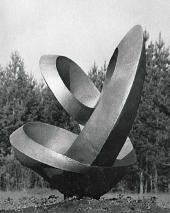
Solenoid. Krasnoyarsk. 1967
Forged aluminium.
Photo from Nikolai Silis archive
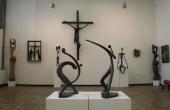
Left:
Discus-thrower. Right:
Shot-putter.
Cement, 1962; bronze, 1980.
Nikolai Silis collection.
Photographer: V. Uskov

Memorial Headstone.
1990s
Private collection.
Photographer: V. Uskov

Pregnant Woman.
1966
Wood. Nikolai Silis collection.
Photographer: V. Uskov
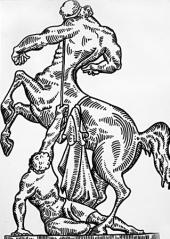
Taming. 1990s
From the “Centaurs” series. A drawing.
Nikolai Silis
collection.
Photographer: V. Uskov
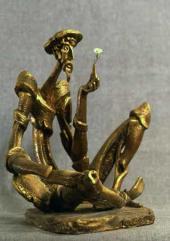
Don Quixote.
Gypsum, 1976; brass, bronze, 1990.
Original in Nikolai Silis collection.
Photographer: V. Uskov
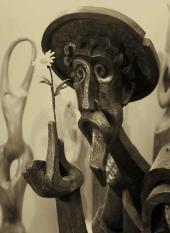
Don Quixote. 1990
Brass, bronze.
Photographer: V. Uskov
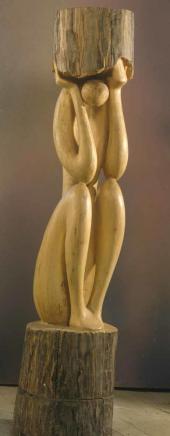
Caryatid. 1990
Wood.
Nikolai Silis collection.
Photographer: V. Uskov
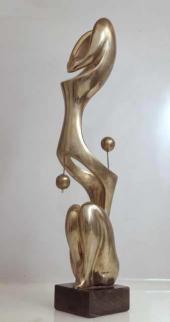
Woman Gymnasts.
Gypsum, 1980; bronze, 1996.
Original in Nikolai Silis collection.
Photographer: V. Uskov
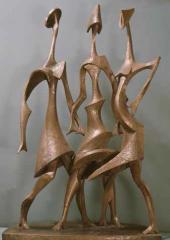
Woman Feminists.
Gypsum, 1970; forged aluminium, 1987
Original in
Nikolai Silis collection.
Photographer: V. Uskov

Lying Woman.
Wood, 1965. Bronze, 1992.
Nikolai Silis collection.
Photographer: V. Uskov
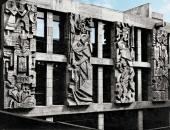
Vladimir Lemport, Nikolai Silis.
Design of a library
courtyard.
Ashgabat. 1970-1971.
Photo from Nikolai Silis archive
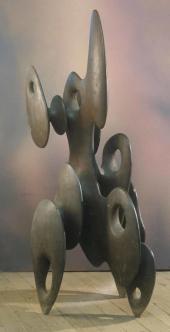
Discus-like. 1985
Tinted gypsum.
Nikolai Silis collection.
Photographer:
V. Uskov

Nikolai Silis in his studio
outside Moscow. 2014
Photographer: V. Uskov

Parasceva. 1971
Welded iron.
Nikolai Silis collection.
Photographer: V. Uskov

Speed Skaters.
Plasticine, 1963; bronze, 1969.
Nikolai Silis
collection.
Photographer: V. Uskov
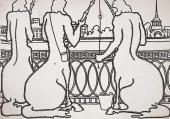
On the Embankment. 1990s
From the “Centaurs” series. A drawing.
Nikolai Silis
collection.
Photographer: V. Uskov
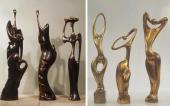
Graces.
Chamotte,
1960; bronze, 1981.
Nikolai Silis collection.
Photographer: V. Uskov
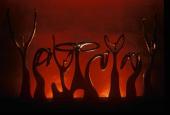
Requiem.
Tinted gypsum, 1971; bronze, 1972.
Nikolai Silis
collection.
Photographer: V. Uskov

Discus-thrower.
Cement, 1962; bronze, 1980.
Nikolai Silis collection.
Photographer: V. Uskov

Fortune.
Chamotte, 1985;
bronze with forged finish, 1989.
Nikolai Silis collection.
Photographer: V. Uskov
|
 home
about
artists
exhibitions press
contact
purchase
home
about
artists
exhibitions press
contact
purchase






















